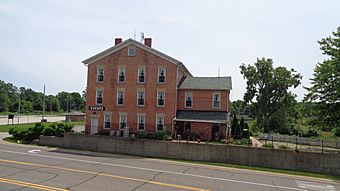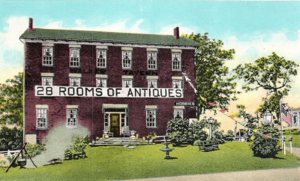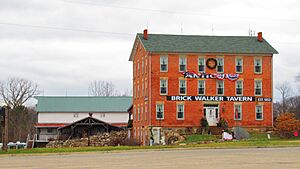S. Walker's Hotel facts for kids
Quick facts for kids |
|
|
Walker's, S., Hotel
|
|

The Brick Walker Tavern in 2019
|
|
| Location | 11705 US-12, Cambridge Township, Michigan |
|---|---|
| Area | 2.2 acres (0.89 ha) |
| Built | 1853 |
| Architectural style | Greek Revival, Italianate |
| NRHP reference No. | 07000381 |
| Added to NRHP | May 2, 2007 |
The S. Walker's Hotel, also known as the Brick Walker Tavern, is an old hotel and tavern building. It is located at 11705 US-12 in Cambridge Township, Michigan. This building was added to the National Register of Historic Places in 2007.
What makes this hotel special is its brick outside and its three stories. Most other old hotel buildings from that time in Michigan were made of wood and only had two stories. Today, the building is used for events and is still called the "Brick Walker Tavern."
Contents
History of the Brick Walker Tavern
Early Days and the Chicago Road
Sylvester and Lucy Walker got married in New Berlin, New York in 1816. By the mid-1830s, they ran a hotel in Cooperstown, New York. Around 1838, they moved to Michigan. They likely rented an inn and tavern across the road from where the brick hotel stands now.
At that time, many people traveled on the Chicago Road. This road was the main path between Detroit and Chicago. In 1842, the Walkers bought the tavern. They named it the Walker Tavern. This old wooden tavern is still standing today.
Building the New Hotel
The Walkers kept running the older wooden tavern until 1853. But in that year, Sylvester Walker decided to build a new, bigger hotel. This new hotel was made of brick and was built at the current spot.
The new brick building was finished in late 1852. It had a separate dining room and a taproom (a place to get drinks) on the first floor. Guest rooms were on the second floor. The third floor had a large ballroom for dances and events.
The Walkers owned both the wooden Walker Tavern and the new brick hotel until 1863. Even though fewer people were using the Chicago Road because of new railroad lines, the Walkers likely stayed in business. Their taproom was popular with local people. In 1859, Sylvester Walker sold the hotel to Silas Giles. But Walker continued to live there until he passed away in 1868.
New Owners and Changes
Silas Giles sold the hotel to William Graves and George Curtis in 1863. They then sold it to Lyman Nearing later that same year. Lyman Nearing was born in New York in 1817. He moved to Michigan just before buying the hotel.
In 1864, Lyman Nearing married Jane Turner. They moved into the hotel. In 1865, they changed the hotel's name to the Nearing House. They owned and managed the hotel until 1887. After them, the hotel was sold a few more times.
Frederick Hewitt and Antiques
In 1922, Frederick Hewitt bought the property. Hewitt was born in England in 1876. He moved to Canada in 1891. He later became a church leader. Hewitt was a good speaker and made many friends. These friends included Alex J. Groesbeck, who became the governor of Michigan, and Henry Ford, who founded the Ford Motor Company.
In the early 1920s, Hewitt became very interested in antiques. He knew the Irish Hills area well. In 1920, he bought a small house and opened an antique shop. In 1922, he bought both the old wooden Walker Tavern and the brick Walker's Hotel.
Hewitt fixed up the brick hotel. He continued to rent out rooms and run a restaurant there. But he also added an antique shop to the building. By 1926, the Chicago Road was paved. This brought many tourists to the area. Hewitt realized that selling antiques was a very good business. He stopped offering rooms and meals. He focused only on antiques.
His important friends helped his business. Both Alex Groesbeck and Henry Ford often visited his antique store. Henry Ford bought many items for his Greenfield Village museum. Other famous visitors included the University of Michigan football coach, Fielding Yost.
Hewitt's antique business was very successful. He opened two more shops, one in St. Augustine, Florida, and one in Chicago. In 1931, he opened the entire Brick Tavern to the public. It was both an antique shop and a museum. During the Great Depression in 1934, Hewitt sold his other stores. He focused on managing another inn nearby. He let his daughter and son manage the two Walker taverns as antique shops.
Later Years and Current Use
In 1965, the Hewitts sold the wooden tavern to the state of Michigan. In 1967, they sold the brick hotel to antique dealers Nells and Joseph Schmidt. After that, different people ran the building as an antique shop.
In the mid-2000s, Tom Lee bought the building. He fixed it up to be a place for weddings and other events. It is now known as the Brick Walker Tavern.
What the Hotel Looks Like
S. Walker's Hotel is a three-story building with a sloped roof. The front of the building has five sections that are the same on both sides. The main door is in the middle. The building shows styles from both Greek Revival and Italianate designs.
It is built with strong red brick walls. It has yellowish-brown sandstone around the windows and doors. A two-story part sticks out from the back of the building. The roof edges have evenly spaced brackets (decorative supports). There are two brick chimneys at each end of the roof.
The front of the building has a center entrance. There are two windows on each side of the door. The doorway itself has narrow windows on the sides and a window above it. The upper floors each have six windows that are spaced out. These windows do not line up with the windows on the first floor. The sides of the building each have four windows on every floor. Most of the windows are original. They have two panes of glass on the top and two on the bottom. Sandstone blocks are above all the windows.
The building is very close to the highway. It sits on a small hill, with a concrete wall holding up the ground. Across the highway is the old wooden Walker Tavern. This tavern is now part of the Cambridge Junction Historic State Park. There are also three other old buildings on the property. Two are barns from around 1870. One barn was built in the 1920s.
Images for kids








